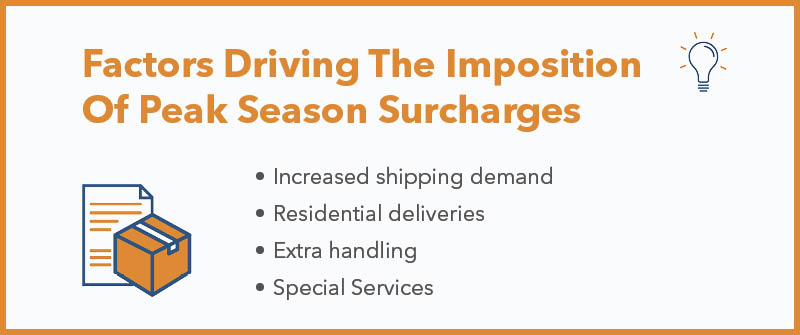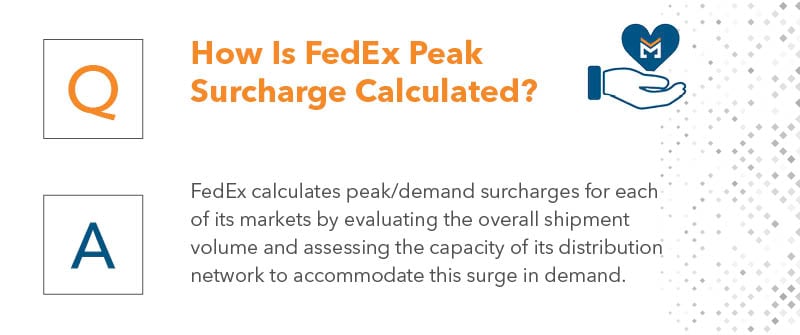What Is Peak Season for FedEx in 2023-2024?
October 5, 2023 •Joe Jordan

The peak season of the year is good news for both retailers and carriers: More sales and more shipping business. So, what is the peak season for FedEx, and how is the peak season surcharge calculated? Let’s find out in this article.
Note: Both UPS and FedEx have moved away from the term "peak season surcharges" and are now using "demand surcharge".
What Is A Peak Season Surcharge?
A peak season surcharge is a special fee that carriers charge during times of the year when shipping demand is significantly higher than usual.
The most prominent peak season is the holiday season between October and January, which is why most carriers announce their peak season surcharges in late August or early September, for shippers to anticipate the coming surcharges.
Factors Driving The Imposition Of Peak Season Surcharges
These are some of the reasons why carriers charge peak season fees:
- Increased shipping demand: During peak seasons, carriers may need to acquire resources to accommodate the unprecedented demand.
- Residential deliveries: During the peak season, carriers often face the challenge of delivering packages to residential areas, as the majority of shipments are destined for homes.
- Extra handling: During holidays and special occasions, packages may require extra handling, including extra care, gift wrapping, and special packaging. This may increase costs.
- Special Services: In a bid to make sure their packages are on time for holidays, many people request extra services like weekend deliveries or storage at carrier facilities.

What Is Peak Season For FedEx in 2023 and 2024?
FedEx's peak season runs from October to January, as most of their demand (peak) season surcharges are imposed from early October to mid-January. It encompasses the period leading up to and during the holiday season, which includes the months of November and December.
This is when FedEx, like other shipping carriers, experiences a significant surge in package volumes due to various holiday-related factors such as Thanksgiving, Christmas, Hanukkah, and New Year's celebrations.
How Long Is Peak Season?
The duration of peak season can vary depending on your carrier, but it typically extends from October to early January, with November and December being the primary months of the peak season.
However, the exact timing and duration of peak season can vary from year to year and may be influenced by consumer behaviors, market conditions, and carrier strategies. Some shipping companies may also experience smaller peak seasons during other times of the year, such as back-to-school or major sales events like Black Friday and Cyber Monday.
Check your carrier's official announcements or contact their customer service to get the latest peak surcharge information.
Who Pays Peak Season Surcharge?
Most of the time, the responsibility of paying the peak season surcharge falls on whoever booked and sent the shipment.
For instance, if the shipper is an online merchant, they can absorb the cost or transfer it to the customer by inflating the cost of the product or service being sold.
In the case of business-to-business (B2B) transactions, the involved parties can mutually decide how to handle these additional charges. This might involve splitting the surcharge costs or having one party assume responsibility for them.
Businesses may be able to mitigate these extra charges by negotiating with their carrier using high-volume shipments and a long-standing relationship as leverage.
How Is FedEx Peak Surcharge Calculated?
FedEx calculates peak/demand surcharges for each of its markets by evaluating the overall shipment volume and assessing the capacity of its distribution network to accommodate this surge in demand. The peak surcharge is then applied to compensate for the constraints.

The peak season surcharge FedEx is applied on a per-package basis, as shown in the table below. To calculate your surcharge, multiply the surcharge amount by the number of packages.
FedEx Demand Surcharges for Domestic U.S. Services
Below is a table detailing FedEx peak season surcharge 2023 and the applicable FedEx peak season dates.
|
Surcharge name |
Applicable services |
2023 Surcharge amount (Oct. 2023–Jan. 2024) |
|
Demand — Additional Handling Surcharge |
U.S. Express Package Services, U.S. Ground Services, International Ground Service |
$6.95 per package |
|
Demand — Oversize Charge |
U.S. Express Package Services, U.S. Ground Services, International Ground Service |
$73 per package (Oct. 2, 2023–Jan. 14, 2024) |
|
Demand — Ground Unauthorized Package Charge |
U.S. Ground Services, International Ground Service |
$410 per package (Oct. 2, 2023–Jan. 14, 2024) |
|
Demand Surcharge |
FedEx Ground Economy Package Services |
$1.60 per package (Oct. 30, 2023–Nov. 26, 2023) |
|
$2.60 per package (Nov. 27, 2023–Dec. 10, 2023) |
||
|
$1.60 per package (Dec. 11, 2023–Jan. 14, 2024) |
||
|
Demand — Residential Delivery Charge* |
FedEx Express |
$2.40 – $7.40 (Oct. 30, 2023–Jan. 14, 2024) |
|
FedEx Ground U.S. domestic residential packages (excluding FedEx Ground Economy, and FedEx One Rate packages). |
$1.35 – $6.35 (Oct. 30, 2023–Jan. 14, 2024) |
*How FedEx’s Demand — Residential Delivery Charge Is Calculated
The Demand — Residential Delivery Charge is not a fixed price but changes dynamically depending on something known as the ‘peaking factor’, which is determined by the customer’s weekly shipping volume.
How the peaking factor is calculated:

*excludes FedEx One Rate packages
To Note:
- The peaking factor and surcharge amount are computed independently for FedEx Express and FedEx Ground.
- In cases where a calculation week encompasses a holiday, the weekly package volume is adjusted by multiplying it by 5 and then dividing it by 4 to compensate for the reduced operating day.
Once the peaking factor is found, it is used to determine the surcharge amount from the table below.
|
Demand — Residential Delivery Charge per Package by Peaking Factor |
||||||
|
>105%–125% |
>125%–150% |
>150%–200% |
>200%–300% |
>300–400% |
>400% |
|
|
FedEx Ground |
$1.35 |
$1.85 |
$2.10 |
$2.65 |
$4.50 |
$6.35 |
|
FedEx Express |
$2.40 |
$2.90 |
$3.15 |
$3.70 |
$5.55 |
$7.40 |
“Calculation week” is the week during which the customer's surcharge is calculated as shown above. “Application week” is the week during which the surcharge is applied based on the corresponding calculation week.
The surcharge amount determined in a Calculation Week will be imposed on the shipper during the corresponding Application Week, which takes place two weeks later, as specified in the table provided below.
|
Peaking period |
Calculation Week |
Application Week |
||
|
1 |
October 9, 2023 |
October 15, 2023 |
October 30, 2023 |
November 5, 2023 |
|
2 |
October 16, 2023 |
October 22, 2023 |
November 6, 2023 |
November 12, 2023 |
|
3 |
October 23, 2023 |
October 29, 2023 |
November 13, 2023 |
November 19, 2023 |
|
4 |
October 30, 2023 |
November 5, 2023 |
November 20, 2023 |
November 26, 2023 |
|
5 |
November 6, 2023 |
November 12, 2023 |
November 27, 2023 |
December 3, 2023 |
|
6 |
November 13, 2023 |
November 19, 2023 |
December 4, 2023 |
December 10, 2023 |
|
7 |
November 20, 2023 |
November 26, 2023 |
December 11, 2023 |
December 17, 2023 |
|
8 |
November 27, 2023 |
December 3, 2023 |
December 18, 2023 |
December 24, 2023 |
|
9 |
December 4, 2023 |
December 10, 2023 |
December 25, 2023 |
December 31, 2023 |
|
10 |
December 11, 2023 |
December 17, 2023 |
January 1, 2024 |
January 7, 2024 |
|
11 |
December 18, 2023 |
December 24, 2023 |
January 8, 2024 |
January 14, 2024 |
For further details, and to view demand surcharges for international shipments, visit the FedEx demand surcharges page.
How ShipSigma Can Help
You've learned how to navigate FedEx's peak season surcharges, but what about securing lower rates overall?
At ShipSigma, we leverage over $1 billion of live market data and AI-backed software to find prime cost-saving opportunities for your company. We’ve already helped 300+ customers save over $100M in shipping costs. Contact us today to get in on the savings!

